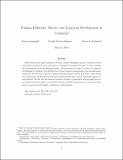Finding Eldorado: Slavery and long-run development in Colombia
Author(s)
Acemoglu, Daron; Robinson, James A.; Garcia-Jimeno, Camilo
DownloadAcemoglu_Finding Eldorado.pdf (5.599Mb)
PUBLISHER_CC
Publisher with Creative Commons License
Creative Commons Attribution
Terms of use
Metadata
Show full item recordAbstract
Slavery has been a major institution of labor coercion throughout history. Colonial societies used slavery intensively across the Americas, and slavery remained prevalent in most countries after independence from the European powers. We investigate the impact of slavery on long-run development in Colombia. Our identification strategy compares municipalities that had gold mines during the 17th and 18th centuries to neighboring municipalities without gold mines. Gold mining was a major source of demand for slave labor during colonial times, and all colonial gold mines are now depleted. We find that the historical presence of slavery is associated with increased poverty and reduced school enrollment, vaccination coverage and public good provision. We also find that slavery is associated with higher contemporary land inequality.
Date issued
2012-08Department
Massachusetts Institute of Technology. Department of EconomicsJournal
Journal of Comparative Economics
Citation
Acemoglu, Daron, Camilo Garcia-Jimeno, and James A. Robinson. “Finding Eldorado: Slavery and Long-Run Development in Colombia.” Journal of Comparative Economics 40, no. 4 (November 2012): 534–564.
Version: Author's final manuscript
ISSN
01475967
1095-7227